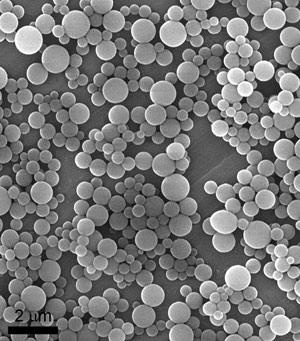Jul 7 2009
A group of researchers at the Catalan Institute of Nanoscience and Nanotechnology (CIN2), belonging to the Catalan Institute of Nanotechnology and the Spanish National Research Council (CSIC) located at the UAB Research Park, and the UAB Department of Chemistry have developed and patented a method which obtains minute organometallic capsules ranging from micrometric to nanometric sizes. These will encapsulate substances in nanospheres containing intrinsic metal properties, such as magnetism, fluorescence or conductivity, which could be useful when applied to radiodiagnostics, electronics or sensors.

Encapsulating substances and then controlling when and how much is released is one of the most recently developed strategies in the fields of chemistry, medicine, material science and environmental technologies. This strategy pursues the idea of the "magic bullet", which has been discussed for a long time, especially in the field of medicine: being able to transport therapeutic substances to the specific place where they are needed.
Until now this technique was possible with liposomes (commonly used in cosmetics), dendrimers (polymeric macromolecules) or polymeric organic particles. In these cases, the capsules are formed by organic molecules. However, encapsulating substances within metal-containing particles had not been achieved until now.
And that is precisely what has been done by the research group at the Catalan Institute of Nanoscience and Nanotechnology (CIN2) - belonging to the Catalan Institute of Nanotechnology and the Spanish National Research Council (CSIC) located at the UAB Research Park - and the UAB Department of Chemistry. Researchers have developed and patented a method to obtain minute organometallic capsules (i.e. formed by a partially organic, partially metallic material) ranging from micrometric to nanometric sizes. The incorporation of metal implies that the nanospheres will contain intrinsic metal properties, such as magnetism, fluorescence or conductivity, which can be useful in medical applications, e.g. radiodiagnostics, electronics or sensors.
The authors of this method are Daniel Maspoch, Inhar Imaz, and Daniel Ruiz-Molina, researchers of the NanoStructured Functional Materials (NanoSFun) group at CIN2, and Jordi Hernando, researcher at the UAB Department of Chemistry. Their names are all included in the article which will be published in the journal Angewandte Chemie International Edition, and which can be found online as one of the journal's highlights.
Efficient and easily scalable method
The method allows for the creation of micro and nanospheres by joining two units: an organic or binding molecule, which acts as an "adhesive", and a metal ion. Generally, the organic molecule shares an electron pair with a metal ion and this gives them the tendency to join. Described simply, the method consists in mixing a solution made up of metal ions, organic molecules and the active principle which is to be encapsulated. When the solution is shaken, either mechanically or with ultrasounds, the metal ions join the organic molecules to form spheres, thus capturing within them the active principle present in the solution. The system is therefore relatively simple and does not present any particular problems with regard to its use at industrial level.
"This simplicity however does not mean that it cannot be used for a variety of purposes. Depending on the composition of the mixture, its concentration, how fast and how long it is shaken, and the speed at which each of the components is added, the size of the nanospheres can be varied, as can characteristics such as the fluorescence or porosity. All these factors can be controlled and varied depending on which application is needed. Thus, porosity is relevant in nanospheres which are programmed to release the substance they contain through the capsule's pores," scientists explain.
In many other cases however, the substance is released during the degradation of the nanosphere, which "disintegrates" at a specific moment (which can also be programmed) and liberates its contents. The units forming the nanosphere (metal ion and organic molecule) can also be changed depending on the type of application desired. Thus, a hypothetic application could be made up of a sphere containing gadolinium, which would enable it to be used as a contrasting agent in radiodiagnostics and at the same time transport the active principal directly to the cells which need to be treated, thanks to the incorporation of an antibody which would detect target cells.
The possibilities are almost unlimited and the selection of molecules not only will depend on the application but on the stability that is expected from the sphere. In the article researchers detail the results achieved with spheres formed with zinc which, according to laboratory tests, can be maintained stable when stored in alcohol for five or six months. This period is reduced to a few days when they are stored in water or blood. Scientists explain that they are nevertheless working on making them more stable.
The advantage of encapsulation versus conventional drug administration processes resides in the fact that it limits the number of side effects by selectively releasing the drug in the specific area where the treatment is needed. Therefore, the amount of drug required is reduced and the necessary levels of the drug are maintained for a longer period of time. This strategy is already being applied to treatments for cancer and other lung diseases. It is calculated that in the United States alone, this business moved approximately 117 billion dollars in the year 2000, a figure which is expected to rise to 366 billion dollars in 2010.